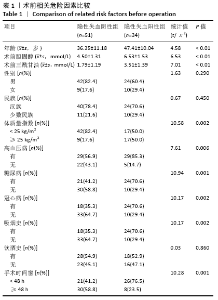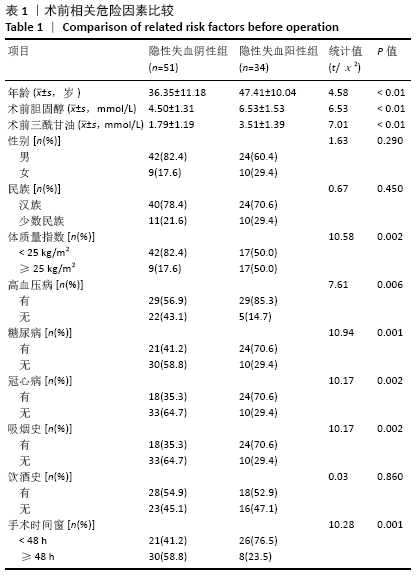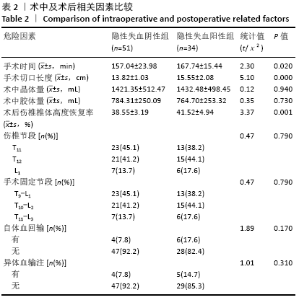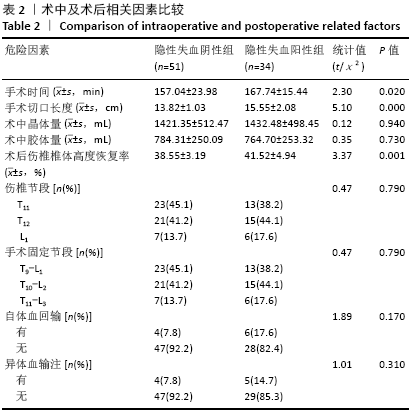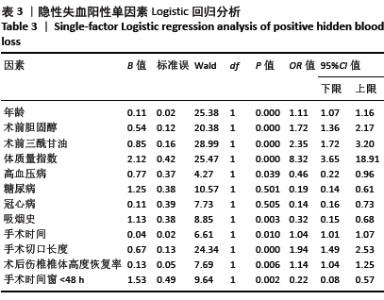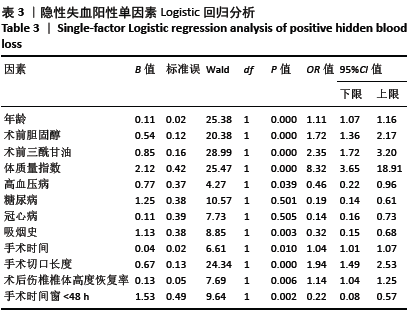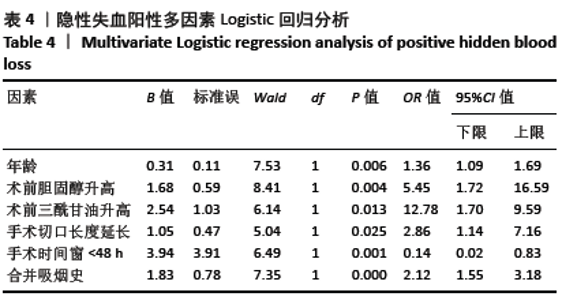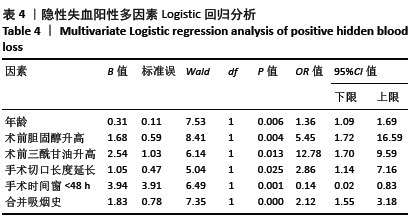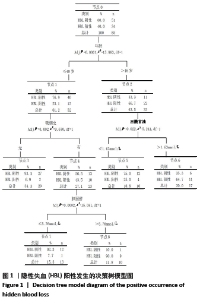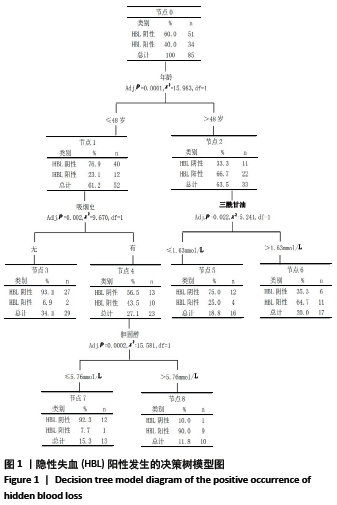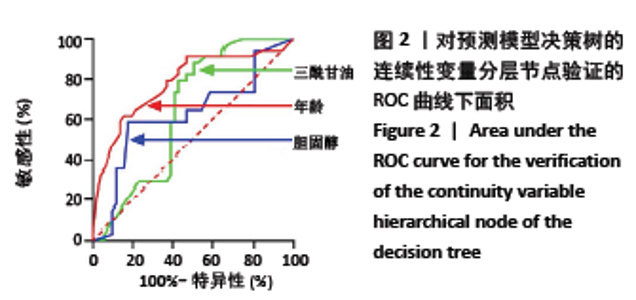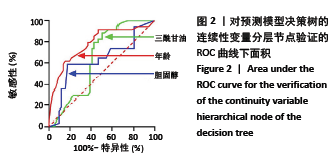[1] BIBLE JE, MIRZA M, KNAUB MA. Blood-loss Management in Spine Surgery. J Am Acad Orthop Surg. 2018;26(2):35-44.
[2] 许川雅,宗亚楠,周阳,等.成人脊柱手术患者术中输血情况的回顾性分析[J].临床麻醉学杂志,2019,35(3):230-234.
[3] 胡雅斌,楚戈,王振斌,等.脊柱手术中隐性失血的初步研究[J].新疆医学,2010,40(4):28-30.
[4] SEICEAN A, SEICEAN S, ALAN N, et al. Preoperative Anemia and Perioperative Outcomes in Patients Who Undergo Elective Spine Surgery. Spine (Phila Pa 1976). 2013;38(15):1331-1341.
[5] KIM BD, SMITH TR, LIM S, et al. Predictors of unplanned readmission in patients undergoing lumbar decompression: multi-institutional analysis of 7016 patients. J Neurosurg Spine. 2014;20(6):606-616.
[6] XU D, REN Z, CHEN X, et al. The further exploration of hidden blood loss in posterior lumbar fusion surgery. Orthop Traumatol Surg Res. 2017;103(4):527-530.
[7] PATTISON E, PROTHEROE K, PRINGLE RM, et al. Reduction in haemoglobin after knee joint surgery. Ann Rheum Dis. 1973;32(6): 582-584.
[8] SEHAT KR, EVANS R, NEWMAN JH. How much blood is really lost in total knee arthroplasty? Correct blood loss management should take hidden loss into account. Knee. 2000;7(3):151-155.
[9] SMORGICK Y, BAKER KC, BACHISON CC, et al. Hidden blood loss during posterior spine fusion surgery. Spine J. 2015;15(9):2114-2115.
[10] SASAJI T, HORAGUCHI K, SHINOZAKI N, et al. Postoperative anemia following posterior decompression surgery for lumbar spinal canal stenosis. Tohoku J Exp Med. 2013;229(1):1-4.
[11] 褚培林,石跃滨,郝鹏,等.胸腰椎爆裂性骨折术后隐性失血的相关因素分析[J].实用骨科杂志,2018,24(7):5-8.
[12] LEI F, LI Z, HE W, et al. Hidden blood loss and the risk factors after posterior lumbar fusion surgery: a retrospective study. Medicine (Baltimore). 2020;99(19):e20103.
[13] WEN L, JIN D, XIE W, et al. Hidden blood loss in posterior lumbar fusion surgery: an analysis of risk factors. Clin Spine Surg. 2018;31(4):180-184.
[14] PARK MS, MOON SH, YANG JH, et al. Neurologic recovery according to the spinal fracture patterns by denis classification. Yonsei Med J. 2013;54(3):715-719.
[15] 赵小华,李敏,王文春,等.脊髓损伤模型损伤程度分级的研究进展[J].中国脊柱脊髓杂志,2019,29(9):860-864.
[16] 康海琼,袁媛,蒙倩茹,等.脊髓损伤神经学分类国际标准检查表2019版最新修订及解读[J].中国康复理论与实践,2019,25(8): 983-985.
[17] 吴成如,汪念,孙军战,等.无骨折脱位型颈脊髓损伤的分类与手术治疗研究[J].颈腰痛杂志,2020,41(1):9-13.
[18] YUKSEL MO, GURBUZ MS, IS M, et al. Is the Thoracolumbar Injury Classification and Severity Score (TLICS) Superior to the AO Thoracolumbar Injury Classification System for Guiding the Surgical Management of Unstable Thoracolumbar Burst Fractures without Neurological Deficit? Turk Neurosurg. 2018;28(1):94-98.
[19] DAWKINS RL, MILLER JH, RAMADAN OI, et al. Thoracolumbar Injury Classification and Severity Score in children: A reliability study. J Neurosurg Pediatr. 2018;21(3):1-8.
[20] WANG H, JIANG J. How to use the load-sharing classification of spine fractures. Eur Spine J. 2015;24(2):406-407.
[21] JIA R, LI N, XU BY, et al. Incidence, influencing factors, and prognostic impact of intraoperative massive blood loss in adolescents with neuromuscular scoliosis: a STROBE-compliant retrospective observational analysis. Medicine (Abingdon). 2017;96(11):e6292.
[22] 张永远,王希骥,赵勤鹏,等.术前静脉应用氨甲环酸对经皮椎弓根螺钉固定胸腰椎骨折手术隐性失血量影响的前瞻性研究[J].中华创伤骨科杂志,2018,20(4):291-295.
[23] 耿珊,陈雄斌,湛斌,等.健康人骨髓CD34+造血干/祖细胞衰老与年龄的相关性研究[J].局解手术学杂,2018,27(9):625-629.
[24] 高慧,朱正球,戴萍,等.超极速脉搏波技术定量评估年龄相关颈动脉弹性衰退的应用价值及平均动脉压对其的影响[J].中国临床医学影像杂志,2020,31(3):167-170.
[25] 成谢锋,詹桥松,戴世诚.一种基于弹性模量的颈动脉衰老模型及其应用[J].南京邮电大学学报(自然科学版),2019,39(2):10-16.
[26] YUAN T, CONG Y, MENG J, et al. Arachidonic acid causes hidden blood loss-like red blood cell damage through oxidative stress reactions. J Surg Res. 2017;211:14-20.
[27] YUAN T, FAN WB, CONG Y, et al. Linoleic acid induces red blood cells and hemoglobin damage via oxidative mechanism. Int J Clin Exp Pathol. 2015;8(5):5044-5052.
[28] GUERRA BA, OTTON R. Impact of the carotenoid astaxanthin on phagocytic capacity and ROS/RNS production of human neutrophils treated with free fatty acids and high glucose. Int Immunopharmacol. 2011;11(12):2220.
[29] CABISCOL E, TAMARIT J, ROS J. Oxidative stress in bacteria and protein damage by reactive oxygen species. Int Microbiol. 2000;3(1):3-8.
[30] ZHANG T, NI S, LUO Z, et al. The protective effect of microRNA-21 in neurons after spinal cord injury. Spinal Cord. 2018;57(2):141-149.
[31] DU J, FAN Y, ZHANG J, et al. Early versus delayed decompression for traumatic cervical spinal cord injury: application of the AOSpine subaxial cervical spinal injury classification system to guide surgical timing. Eur Spine J. 2019;28(8):1855-1863.
[32] LI HL, XU H, LI YL, et al. Epidemiology of traumatic spinal cord injury in Tianjin, China: an 18-year retrospective study of 735 cases. J Spinal Cord Med. 2018;(3):1-13.
[33] 罗永立,许汉权,庞祖才.胸腰椎骨折手术时机与隐性失血的相关性研究[J].吉林医学,2011,32(35):7448-7449.
|
